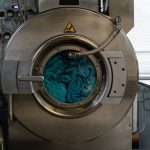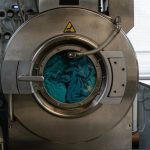Hey there! Did you know that sewing on plastic is totally doable?
In 'Can You Sew on Plastic? a Guide to Working With Different Fabrics,' you'll master the art of sewing with various materials. From delicate fabrics to heavy-duty ones, this guide has got you covered.
You'll learn essential tools for sewing plastic, tips for handling stretchy materials, and techniques for sewing water-resistant fabrics.
Plus, you'll discover how to embellish with decorative plastic elements and troubleshoot common sewing issues.
Get ready to elevate your sewing game and tackle any fabric with confidence!
Key Takeaways
- Understanding fabric types is crucial when sewing on plastic
- Delicate handling is required for silk fabrics
- Testing on scrap fabric before sewing delicate fabrics is recommended
- Using the right tools, such as Teflon presser foot and heavy-duty sewing machine needle, is important for sewing on plastic.
Understanding Different Fabric Types
When sewing on plastic, understanding different fabric types is essential for achieving successful results. It's important to comprehend the unique characteristics of each fabric in order to sew on them effectively.
Understanding silk fabrics is crucial as they're delicate and require special handling. When working with silk, it's essential to use sharp needles and to sew with precision to avoid damaging the fabric.
Additionally, sewing satin materials requires attention to detail due to their slippery nature. Using fine, sharp needles and sewing slowly can help prevent any fabric shifting or puckering. Silk and satin both demand careful handling to achieve professional-looking results.
Mastering the art of sewing on these delicate fabrics will elevate your sewing skills and broaden the range of projects you can undertake. It's important to always test on scrap fabric first to ensure you're using the correct techniques and settings for your specific fabric.
With patience and practice, you can confidently sew on silk and satin, expanding your repertoire of sewing capabilities.
Essential Tools for Sewing Plastic
To sew on plastic effectively, you'll need essential tools that complement the unique characteristics of this material while ensuring precise and secure stitching. When sewing plastic, it's crucial to use the right tools to achieve professional results.
One essential tool for sewing plastic is a Teflon presser foot. This specialized foot prevents the plastic from sticking to the presser foot or the needle plate, allowing for smooth and even stitching.
Additionally, using a size 14 or 16 needle designed specifically for heavy fabrics or leather will help penetrate the plastic without causing damage.
It's also important to have a pair of sharp fabric scissors designated for cutting plastic fabric. These scissors should be durable and able to cleanly cut through the material without causing jagged edges.
Furthermore, using clips instead of pins to hold the plastic fabric in place will prevent unnecessary puncture marks.
Lastly, a non-stick sewing machine needle is crucial for sewing plastic as it reduces skipped stitches and ensures a consistent stitch quality.
These essential tools will facilitate a smooth and successful sewing experience when working with plastic fabric.
Tips for Sewing Delicate Fabrics
Sewing delicate fabrics requires precision and finesse to ensure optimal results. When working with fragile materials such as silk and satin, it's crucial to employ the right techniques and tools to avoid damaging the fabric.
Here are some essential tips for sewing delicate fabrics:
- Silk Stitching Techniques: When sewing silk, use a fine needle and silk thread to prevent snags and pulls. Adjust the tension on your sewing machine to accommodate the delicate nature of the fabric. Consider using tissue paper or a stabilizer underneath the silk to provide support and prevent it from getting caught in the feed dogs.
- Delicate Fabric Handling: Handle delicate fabrics with care, avoiding excessive pulling or stretching. Use sharp fabric scissors to ensure clean, precise cuts without causing fraying. When pinning the fabric, opt for fine, silk pins to minimize damage.
- Satin Sewing Tips: When sewing satin, reduce the pressure on the presser foot to prevent the fabric from puckering. Consider using a walking foot to feed the fabric evenly and prevent slippage. Additionally, test stitches on a scrap piece of satin to determine the appropriate tension and stitch length before sewing the actual garment.
- Fragile Material Sewing Tricks: For other fragile materials, such as chiffon or lace, use a fresh needle to avoid snagging and create smooth, even stitches. Always practice on a scrap of the fabric beforehand to ensure your machine settings are suitable for the delicate material.
Techniques for Sewing Stretchy Materials
When sewing stretchy materials, it's important to use the right techniques to ensure a professional finish. From choosing the correct needle and thread to adjusting the tension on your sewing machine, there are several key points to consider.
Handling elastic fabrics requires a different approach, and understanding these techniques will help you achieve the best results.
Sewing Elastic Fabrics
Before beginning your project with elastic fabrics, it's important to select the correct needle and thread for the material. When sewing with elastic fabrics, there are several techniques that can help you achieve professional results.
Here are four essential tips to keep in mind:
- Elastic thread usage: Utilize elastic thread in the bobbin to create stretchable seams that move with the fabric.
- Stretch stitch techniques: Experiment with stretch stitches on your sewing machine, such as zigzag or triple straight stitch, to accommodate the fabric's elasticity.
- Needle selection: Opt for a ballpoint or stretch needle to prevent skipped stitches and fabric damage.
- Tension adjustments: Adjust the tension on your sewing machine to ensure proper stitch formation and prevent fabric puckering.
Handling Stretchy Materials
To successfully handle stretchy materials when sewing, you need to adjust your sewing machine settings to accommodate the fabric's elasticity.
When working with stretchy fabrics such as spandex, it's crucial to use the appropriate techniques to ensure professional-looking results.
Start by using a stretch needle, which has a deeper scarf to prevent skipped stitches.
Additionally, consider using a walking foot to help feed the fabric evenly and prevent stretching.
When sewing spandex, it's recommended to use a narrow zigzag stitch or a serger to allow the seam to stretch with the fabric.
Remember to test your stitch on a scrap of the same fabric to ensure it provides the necessary stretch.
Sewing on Water-Resistant Fabrics
When sewing on water-resistant fabrics, consider using a specialized needle to prevent damage to the material. These fabrics, such as nylon, polyester, or vinyl, require specific techniques to ensure successful stitching.
Here are some essential tips for sewing on water-resistant fabrics:
- Use a sharp needle: A sharp needle, such as a Microtex or a ballpoint needle, can easily penetrate water-resistant fabrics without causing snags or damage.
- Choose the right thread: Opt for a high-quality polyester or nylon thread, as these materials are more resistant to water and will ensure your stitches remain strong and durable.
- Adjust your machine settings: When working with water-resistant fabrics, adjust your machine's tension and stitch length to accommodate the material's density and thickness.
- Consider using a walking foot: A walking foot can help feed the fabric evenly through the machine, preventing any potential slipping or shifting during stitching.
Working With Heavy-Duty Fabrics
Ready to tackle heavy-duty fabrics?
Whether you're sewing on vinyl, tackling denim, or working with canvas, there are specific tips and techniques to keep in mind.
From choosing the right needles and thread to adjusting your machine settings, we'll cover everything you need to know for successful sewing with these tough materials.
Let's dive into the specifics of sewing on heavy-duty fabrics and master the art of creating durable and professional-looking projects.
Sewing on Vinyl
You can sew vinyl fabric using a heavy-duty sewing machine needle to ensure smooth stitching. When working with vinyl, consider the following tips to achieve the best results:
- Use a longer stitch length to prevent tearing or puncturing the fabric.
- Consider using a Teflon or roller foot to help the vinyl glide smoothly under the presser foot.
- Place tissue paper or a layer of stabilizer between the vinyl and the machine's feed dogs to prevent sticking.
- Avoid using pins, as they can leave permanent holes in the vinyl; instead, use clips or double-sided tape to hold the fabric in place.
Denim Stitching Tips
For stitching heavy-duty fabrics like denim, you'll need to adjust the machine settings and use a denim needle to ensure smooth sewing. When hemming denim or topstitching on jeans or denim jackets, there are specific tips to keep in mind. Here are some essential denim stitching tips to help you achieve professional-looking results:
| Denim Stitching Tips | |
|---|---|
| Adjust Stitch Length | Experiment with longer stitch lengths (3mm-4mm) to prevent skipped stitches and ensure strong seams. |
| Use Heavy-Duty Thread | Opt for a robust thread, like topstitching or jeans thread, to withstand the heavy-duty nature of denim fabric. |
| Consider Multiple Passes | For thick denim seams, consider sewing multiple passes to ensure durability and strength. |
| Backstitching | Always backstitch at the beginning and end of your seams to secure the stitches. |
Canvas Sewing Techniques
When working with heavy-duty fabrics like canvas, it's important to adjust your machine settings and use the appropriate needle to ensure smooth sewing, just as you did with denim.
Canvas sewing requires specific techniques to handle the thickness and durability of the fabric. Here are essential tips for mastering canvas sewing:
- Needle selection: Use a heavy-duty needle, such as a size 16 or 18, to penetrate the dense fibers of the canvas.
- Machine settings: Adjust the tension and stitch length on your sewing machine to accommodate the thickness of the canvas.
- Seam finishing: Consider using flat-felled seams or binding to reinforce the strength of the canvas seams.
- Fabric care: Pre-wash and pre-shrink the canvas fabric to prevent distortion or shrinkage after sewing.
Embellishing With Decorative Plastic Elements
To embellish your fabric with decorative plastic elements, start by gathering the materials you'll need for the project. Decorative plastic embellishments can add a unique and stylish touch to your fabric creations. Begin by choosing the type of plastic elements you want to incorporate, such as beads, sequins, or buttons. These elements come in a variety of shapes, sizes, and colors, allowing you to unleash your creativity and personalize your fabric in endless ways.
Once you have your decorative plastic elements, consider the fabric you'll be working with and the overall design you want to achieve. Whether you're embellishing a garment, a bag, or a home decor item, the placement and arrangement of the plastic elements can greatly impact the final look. Use a needle and thread or fabric glue to secure the plastic embellishments onto the fabric. Ensure that the attachments are secure, especially if the fabric will undergo regular use or washing.
Experiment with different combinations and placements to create eye-catching and creative fabric embellishments. With the right materials and techniques, you can elevate your fabric projects with decorative plastic elements that showcase your individual style and imagination.
Troubleshooting Common Fabric Sewing Issues
Experiencing tension problems while sewing plastic fabrics can often be attributed to using the wrong needle size. When dealing with fabric challenges, it's essential to troubleshoot common sewing issues to ensure the quality of your work.
Here are some common solutions to fabric challenges when sewing plastic materials:
- Needle Selection: Ensure you're using a needle specifically designed for sewing on plastic fabrics to avoid tension problems and ensure smooth stitching.
- Thread Tension: Adjust the thread tension on your sewing machine to accommodate the unique properties of plastic fabrics, preventing puckering or bunching.
- Stitch Length: Experiment with different stitch lengths to find the optimal setting for sewing on plastic fabrics, as shorter stitches can help prevent tearing or distorting the material.
- Presser Foot Pressure: Adjust the presser foot pressure on your sewing machine to ensure that the fabric is feeding smoothly through the machine without stretching or warping.
Frequently Asked Questions
Can You Sew on Plastic Using a Regular Sewing Machine Needle?
Yes, you can sew on plastic using a regular sewing machine needle. Make sure the needle is compatible and use a sewing machine foot suitable for transparent materials. Employ ironing techniques and prevent sticking with the right tools.
What Type of Thread Is Best for Sewing on Plastic?
When sewing on plastic, the best thread to use is polyester or nylon. These threads are strong and durable, making them suitable for sewing on plastic. Ensure you use a sewing machine needle designed for plastic materials to prevent breakage.
Are There Any Special Techniques for Sewing on Transparent Plastic Materials?
When sewing on transparent plastic, use a Teflon foot to prevent sticking and a longer stitch length for better results. Consider using a non-stick sewing machine needle and transparent thread for a clean finish.
Can You Use an Iron on Plastic Fabric to Create Seams?
Yes, you can use an iron on plastic fabric to create durable seams. Plastic fabric properties make it suitable for ironing. Follow specific guidelines to ensure a secure bond and avoid damaging the fabric.
What Are Some Tips for Preventing Plastic From Sticking to the Sewing Machine Foot?
To prevent plastic from sticking to the sewing machine foot, apply non-stick spray to the foot before sewing. Alternatively, consider using a Teflon presser foot when sewing plastic, as it is designed to prevent sticking.
- Does Linen Keep You Cool at Night? - April 9, 2024
- Is Linen Cool for Sleeping? - April 9, 2024
- Is Linen Sun Proof? - April 9, 2024







